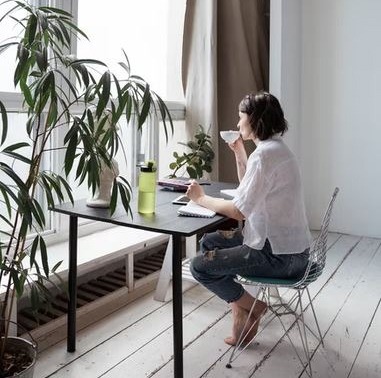Working from home sounded appealing until you realized you didn’t have a work desk or enough floor space to accommodate one. You only have a dining table with enough surface area to make a transitional work desk. It can, however, be of assistance. Dining tables are an outstanding transitional or permanent work desk with a large workspace suitable for a variety of tasks. So, should you use your dining table as a work desk? As long as it meets the criteria, you can use it as a work desk.
Why You Should Use Your Dining Table as a Work Desk?
1. From every angle, the dining table is appealing
Have you ever noticed how some desks have a partially finished back? Like you’re going to lean it against a wall and stare at it? It’s also not a particularly appealing appearance or viewpoint. Furthermore, they have the appearance of a large brick blocking all sightlines through the room. The incorrect desk can eliminate the possibility of certain layouts in your space. What if you want your desk to be in the middle of the room? It could have put the desk in the opposite direction, with a chair against the bookshelves looking out. If it had been a desk, that would have been a fantastic look. With a dining table, you have two fantastic layout options, but with a standard desk, you may be limited in how you can turn it.
2. Dining tables are shared areas
Consider this: why not create a shared workspace in your home? How to share a home office with two people? I’m sure your children do their schoolwork at the dinner table. This is due to the ample space for multiple workers to spread out. You can sit next to your child and assist them, or your children and their mates can collaborate. It’s also ideal if you have multiple clients who need to see the same drawing, mood board, or book draft. It’s just smart to have a space in which more than one individual can work.
3. Dining Tables have bigger sizes
They are bigger, so you’ll have more room to work, and the table’s big chunky look makes a big statement in the room. It can also help you concentrate on your work because the space is not suffocating.
4. You have your Laptop, so you need a bigger table
People used to need a keyboard tray and a filing cabinet drawer, but nowadays, most of us with a home office have a laptop, and a stationary filing system will not meet our organizational needs. If you are the type of person who requires everything to be present at all times, your dining table may be the best option for you.
5. Several Choices
There are dining tables everywhere. It’s even available on sale. You will have more options and will be able to choose what best suits your needs.
How Can You Make Your Dining Room a Home Office?
1. Task lighting is required
Even if your dining area has plenty of natural light, one or two task lights should be added to avoid eye strain. It also aids your productivity by providing a pleasant environment for your eyes.
2. Bins help to compartmentalize
Keep all of your work supplies in a bin or basket that you can carry to and from the kitchen table as needed, as seen in hoteling workplace setups. Keep everything there: connectors, pens, notepads, organizers, audio equipment, and even a sleeve for your work laptop. This way, you can spread out all of your work-from-home tools during peak hours and easily clear everything away when you’re done for the day; use the empty bin to store whatever was left on the kitchen table after breakfast when all of your work stuff is out.
3. Enhance your Chair set
Not to be rude, but I have a feeling your kitchen chairs were not designed to be sat in all day. Ergonomics and back support are more important if you are going to be seated for several hours—so trying to settle for whatever you sit in for breakfast is not going to cut it in the long run. At best, it is inconvenient; at worst, you are endangering your back.
4. Defining the area
A desk pad, which is similar to a placemat but is used for working rather than eating, instantly transforms your tabletop into an office zone. Yes, it’s retro, but it serves a purpose: a desk pad protects your kitchen table from pen marks and scratches, provides a smooth surface for mouse use and is easy to clean.
5. Power Station
Is there a significant distinction between such a kitchen counter and an office setup? Electricity is available. Extending a ton of cords and cables from your workspace to the closest outlets is just setting yourself up to trip if you need to keep multiple electronics and accessories charged throughout the day. A compact surge protector with both standard and USB ports keeps things tidy and fully powered. To keep everything running smoothly, use only one outlet near the table; wrap the excess cable in cord straps to keep the tabletop from becoming tangled.
6. Employ an electrician to put in a convenient electrical outlet
In the dining room, the closest outlet is awkwardly placed at shoulder height near a door. It is not safe to run an extension cord from a high point across the dining table for the laptop. Installing a nearby outlet or strategically positioning your dining table will facilitate access and reduce cable clutter.
7. It is a need to invest in some height
A simple tabletop converter is a more elegant and less precarious solution than making a standing desk out of a tall stack of cookbooks. When you need it, collapsible models add height to your kitchen table, and when you don’t, they store easily. If you want something stylish and adjustable that disassembles completely when not in use, consider a wooden scaffolding version.
8. Consider using a tablecloth or runner
Working at a desk causes the surface to wear out faster. Scratches can be avoided by using a tablecloth or runner. Any peripherals or tech accessories installed on the table’s underside can also be hidden.


